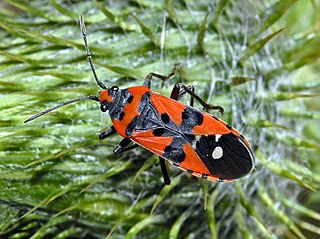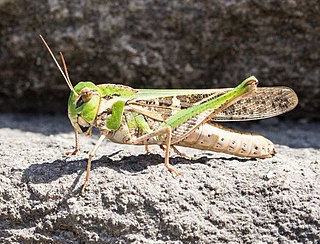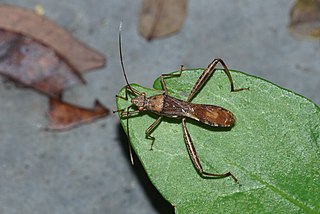| Prionolomia | |
|---|---|
 | |
| Prionolomia heros | |
| Scientific classification | |
| Kingdom: | |
| Phylum: | |
| Class: | |
| Order: | |
| Family: | |
| Subfamily: | |
| Genus: | Prionolomia Stal, 1873 |
| Synonyms | |
| |
Prionolomia is a genus of the squash bugs belonging to the family Coreidae. [1]
| Prionolomia | |
|---|---|
 | |
| Prionolomia heros | |
| Scientific classification | |
| Kingdom: | |
| Phylum: | |
| Class: | |
| Order: | |
| Family: | |
| Subfamily: | |
| Genus: | Prionolomia Stal, 1873 |
| Synonyms | |
| |
Prionolomia is a genus of the squash bugs belonging to the family Coreidae. [1]

Pentatomidae is a family of insects belonging to the order Hemiptera, generally called shield bugs or stink bugs. Pentatomidae is the largest family in the superfamily Pentatomoidea, and contains around 900 genera and over 4700 species. As hemipterans, the pentatomids have piercing sucking mouthparts, and most are phytophagous, including several species which are severe pests on agricultural crops. However, some species, particularly in the subfamily Asopinae, are predatory and may be considered beneficial.

The family Fulgoridae is a large group of hemipteran insects, especially abundant and diverse in the tropics, containing over 125 genera worldwide. They are mostly of moderate to large size, many with a superficial resemblance to Lepidoptera due to their brilliant and varied coloration. Various genera and species are sometimes referred to as lanternflies or lanthorn flies, though they do not emit light.

Pentatominae is a subfamily of Pentatomidae, a family of shield bugs. This subfamily is the largest one within the pentatomidae, having 4937 species. classified in 938 genera. Species on this subfamily are phytophages and several of them have been considered agricultural pests. Some invasive pentatomines such as Halyomorpha halys and Bagrada hilaris have been considered household pests, even inflicting adventitious bites. Higher systematics of the group has been revised by Rider et al.

The subfamily Pseudophyllinae contains numerous species in the family Tettigoniidae, the katydids or bush crickets. Sometimes called "true katydids", together with the crickets of suborder Ensifera, they form part of the insect order Orthoptera which also contains grasshoppers.

Sphedanolestes is a large genus of assassin bugs in the family (Reduviidae), subfamily Harpactorinae. There are more than 190 described species, which are found in southern Europe, Africa and Asia.

Rhynocoris is a genus of assassin bug, family (Reduviidae), in the subfamily Harpactorinae. Species are recorded from Asia, mainland Europe, Africa and North America.

Acanthaspis is a genus of assassin bugs. Members of the genus are known to disguise themselves by attaching bits of debris to aid in camouflage.
Holotrichius is a genus of assassin bugs.

Sycanus is a genus of assassin bug with many species that are found in the African and Asian region.

Ischnodemus is a genus in the true bug family Blissidae. The review by Slater (1979) listed 95 species. The genus is found in all major zoogeographic regions, being most abundant on various species of Gramineae. The bodies of the adults are moderately to very elongated. The genus name was coined to refer to this slenderness, from the Greek ἰσχνόσ (ischnos) "feeble" and δέμασ (demas) "body".

Coranus is a genus of assassin bugs in the tribe Harpactorini.

Lygaeus is a genus of seed bugs in the family Lygaeidae. There are at least 70 described species in Lygaeus.

Lampromicra is a genus of true bugs in the family Scutelleridae. They are commonly referred to as jewel bugs or metallic shield bugs.

Piezogaster is a genus of leaf-footed bugs in the family Coreidae. There are at least 30 described species in Piezogaster.

Oncopeltus is a genus of seed bugs in the family Lygaeidae. There are at least 40 described species in Oncopeltus.

Caedicia is a genus of bush crickets or katydids in the subfamily Phaneropterinae. Species can be found Australasia, with records from Vietnam, Papua New Guinea, and Australia.

Gastrimargus is a genus of grasshoppers in the subfamily Oedipodinae. The recorded distribution of species in this genus includes Africa, Asia, and Oceania.

Riptortus is a genus of broad-headed bugs in the family Alydidae. There are more than 20 described species in Riptortus.
| | This Coreoidea article is a stub. You can help Wikipedia by expanding it. |